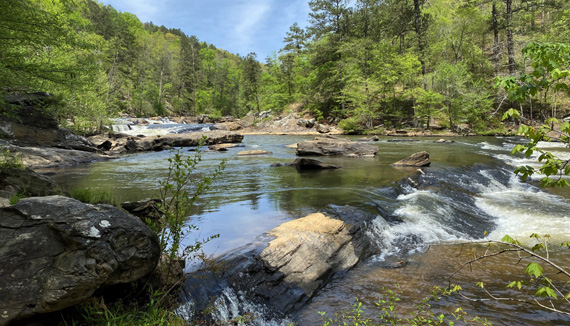As the Covid pandemic was morphing in 2021 and everyone
started learning better how to live with it in public places, Jim and I still found
comfort and joy choosing to spend most of our time in our cozy home with
three lovable Labrador retrievers and a pretty yard.
We suffer less from social isolation than many people because we just
aren't social butterflies any more.
Gardening and nature have always been a refuge for me. During all the
stress of the pandemic I found even more solace than usual in literally "playing in the
dirt." I don't know that it has taught me much patience or grace, but it's
definitely therapeutic to plan, plant, and maintain our landscape and
enjoy watching it flourish. It brings me peace.

Home sweet home, c. July, 2021
We spent thousands of dollars on plants the first couple years we
lived here (2017-18) because most of the back yard and part of the front were so
barren. Most of the shrubs, trees, groundcovers, and perennials we planted have
thrived and grown, some beyond our expectations. Others have not.
That's how it is with gardening! I choose to enjoy what has
flourished, try to learn from the "failures," and move on.
I chose almost seventy photos from our yard to feature in this series
of two entries, both dated August 17. They span the entire year. I'll
start with plants that begin to bloom in early spring and continue
somewhat chronologically through summer, fall, and winter. Some plants
overlap two or three seasons.
FEBRUARY TO APRIL
We were fortunate to have some large Lorapetalum AKA Chinese
fringe flower shrubs in our front yard when we bought this property.
There are several on either side of the front yard and we've planted a
couple more in the back yard.
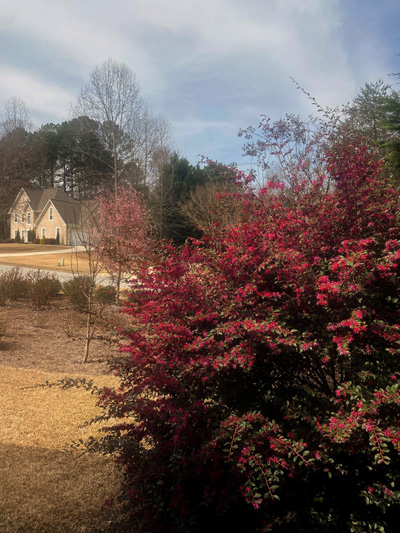
View from my computer desk
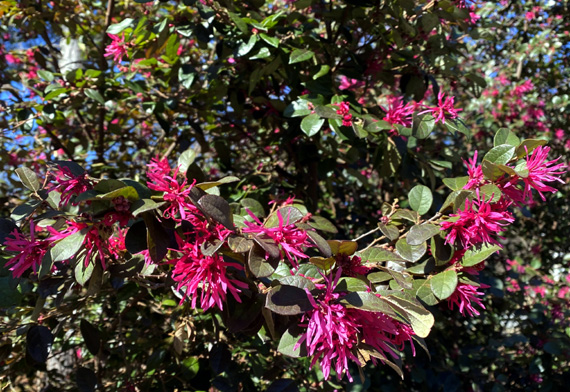
The varieties we have get very tall and wide. They have beautiful dark
pink or reddish purple flowers almost year-round (they peak in
February) and they keep their pretty green and dark red leaves all
year. All they require is some pruning and adequate rainwater. Easy peasy!
We planted this Okame cherry tree in the front garden island
in 2018 and it has amazed us every year with two separate blooming
periods when we expected only the one in early spring.

It is covered in beautiful pale pink blossoms for a week or two in February. Its leaves are nice green until August, when they drop and are
replaced by more flowers and leaves in September! Then the leaves drop
again for several months in the winter. We've done only a little shaping
of the branches so far.
We also have two common forsythia shrubs in the back yard that
have pretty yellow flowers in February. I don't have any new photos of
those. Our Mathotinia camellia is supposed to bloom in February
or March but we got only a couple flowers from the numerous buds this
year. That shrub is a disappointment because it bloomed well the first
three years.
In March our Spirit viburnum produces lots of pretty
white-to-pink blooms:
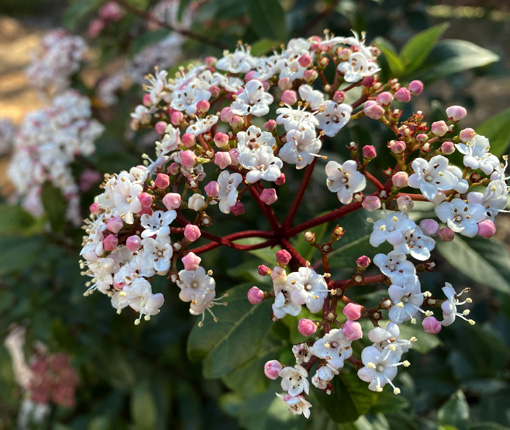
This shrub is about six feet tall now and rebloomed unexpectedly in
the fall this year. I appreciate that its leaves are evergreen. One
large branch died so I'm hoping other branches/leaves will fill in the
hole in a couple years. (Patience!)
Several varieties of daffodils and narcissus bloom in the
front yard in March. Sometimes those come back again in the fall, too.
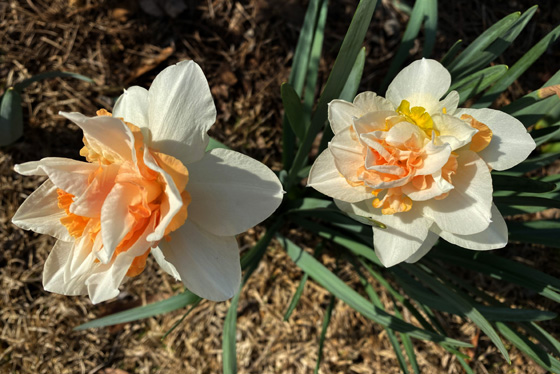
The back yard really comes alive in April with columbines, bearded
iris, pink dogwood, snowflake virburnum, azaleas blooming.
We started off with a few columbine seeds from a neighbor and
they quickly spread into a large patch that stays partially green
throughout the year. I love all the pretty colors of the delicate
flowers, from a range of blues, pinks, and purples:
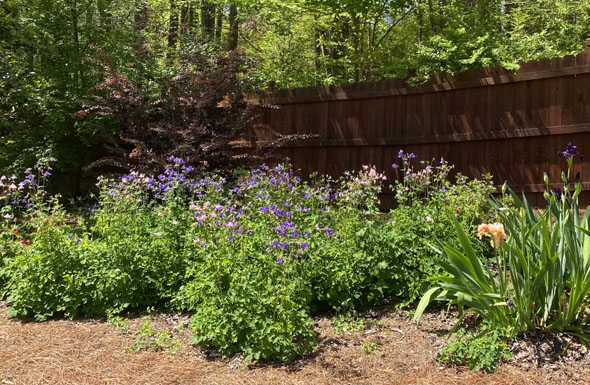
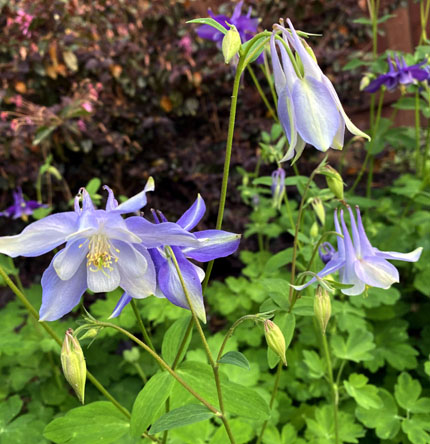
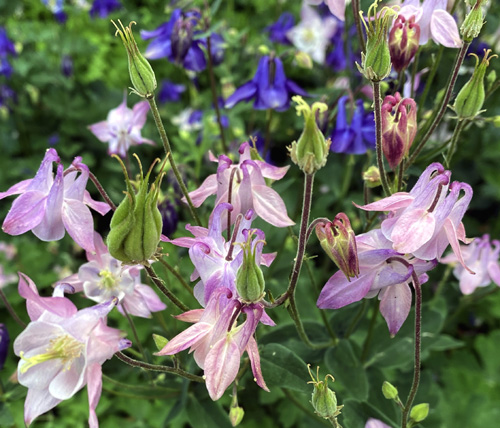
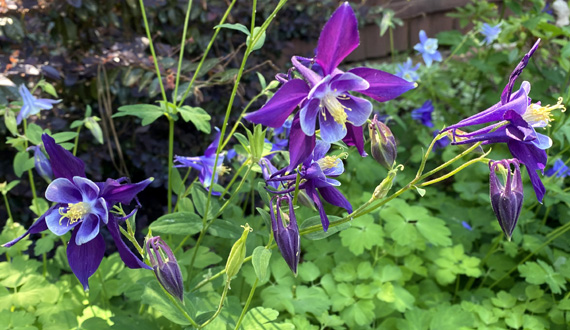
There is a bed with seven different colors of bearded iris at
one end of the columbine patch. All but one of the irises rebloom in the
fall, although their main show is in the spring.
The first two photos below of my favorite iris are from this spring
and the yellow ones are from October:
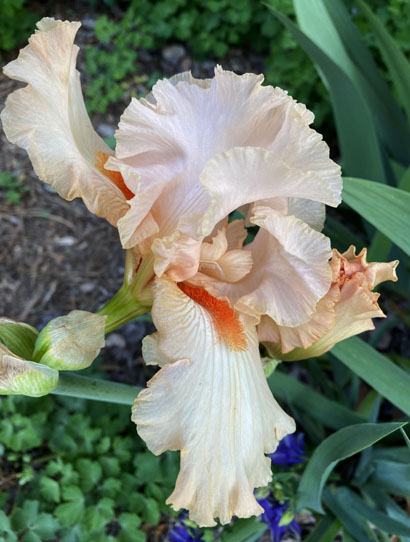
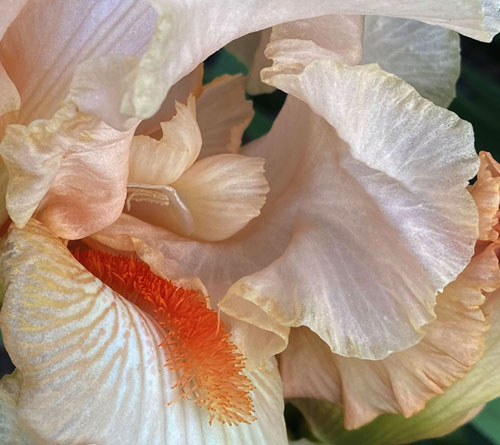
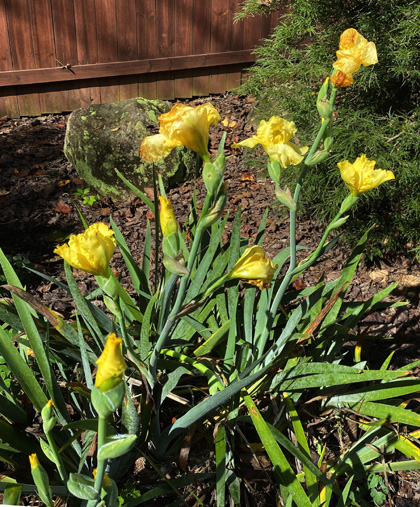
Our pink dogwood tree hasn't been the greatest success since
we planted it four years ago, but at least it's mostly still alive (a
few branches died) and it has some pretty pink flowers in April:
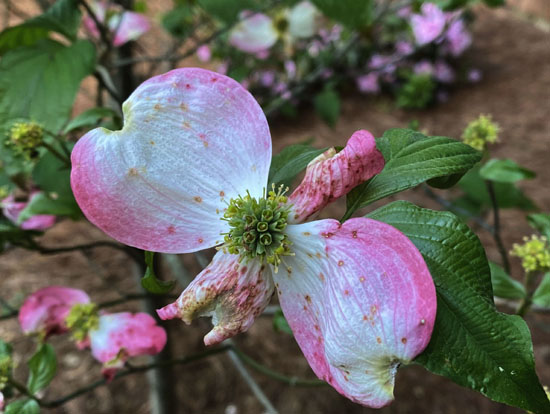
I think the main problem was planting it too far back in our yard,
where it's under a canopy of tall trees and probably doesn't get enough
sunlight. It's too big to move now.
Just in front of the pink dogwood are two very tall snowflake
virburnum shrubs that have gotten way bigger than advertised! They
are so tall they also block sunlight to the dogwood. They are very pretty shrubs/trees, though,
with lots of white bracts of flowers in April and May:
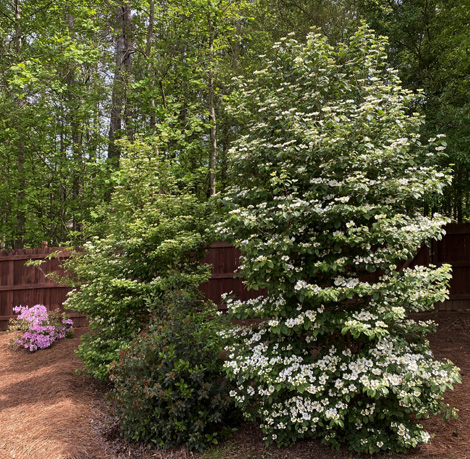
L-R: pink GLTabor azalea, pink
dogwood behind one snowflake viburnum,
shorter spirit viburnum, and
taller snowflake viburnum
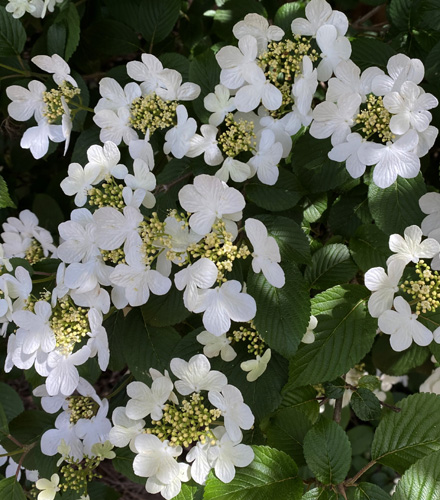
A few feet in front of the virburnums are three barberry shrubs
that have also done quite well. They have a multitude of pastel-colored
leaves in the spring and some very tiny yellow flowers:
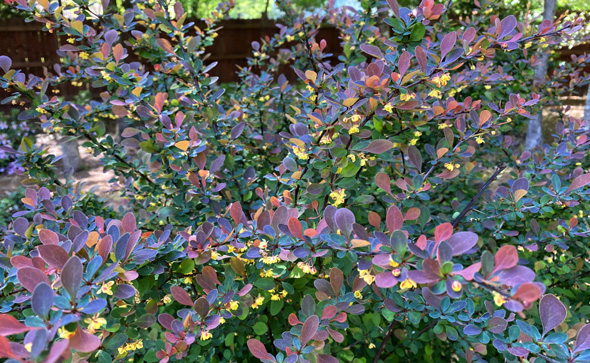
The barberry leaves are mostly green in the summer, turning to reds and
oranges in the fall. These deciduous shrubs drop their leaves in the winter.
Encore azaleas were very prominent in our front and back
gardens in my original landscape designs. We planted about fifty of them
the first two years, but they have not been successful in our yard.
After a few attempts at getting refunds and replacing them with new
Encores that also died, I now just leave the spots empty or replace them
with something else.
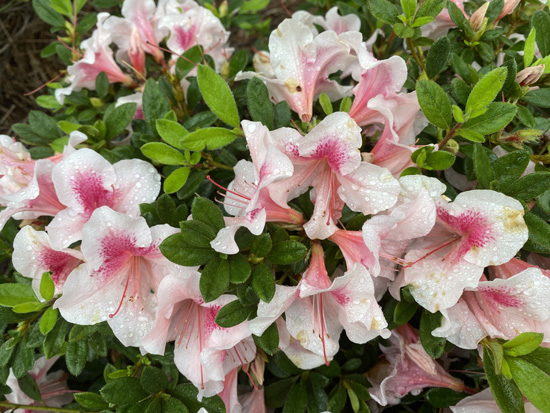
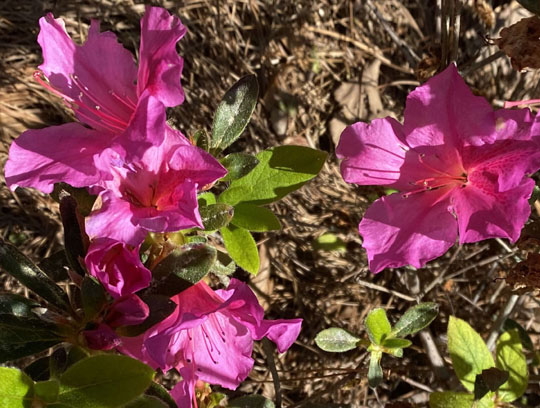
Encores come in several dozen colors and sizes. They bloom at least
twice a year, and come in early, mid-season, and late varieties. They
retain their leaves in winter. They have a lot going for them, but I
just couldn't figure out why they don't do well in our yard.
We have only about ten of them left, in various colors. Since their
bloom cycles vary, we have some in bloom from April until the first hard
frost in December.
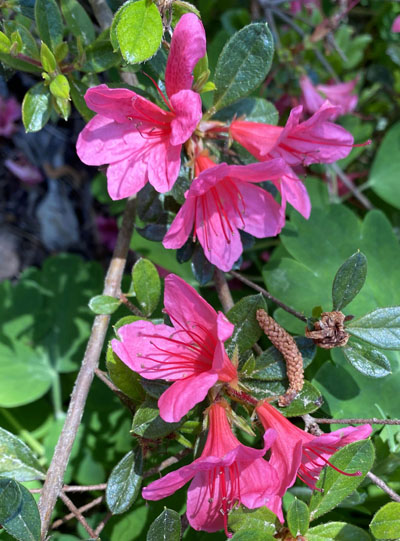
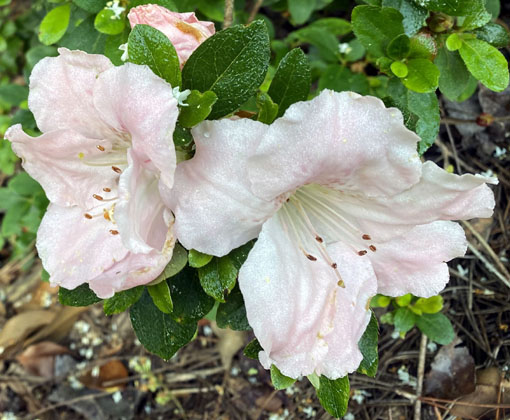
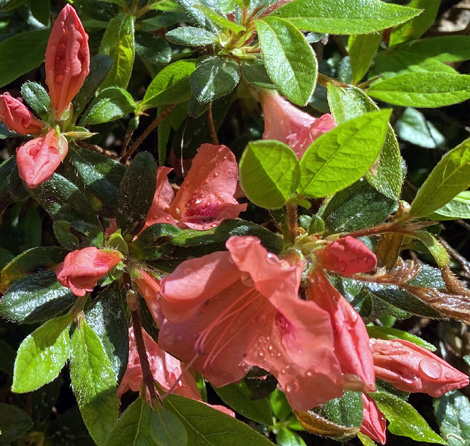
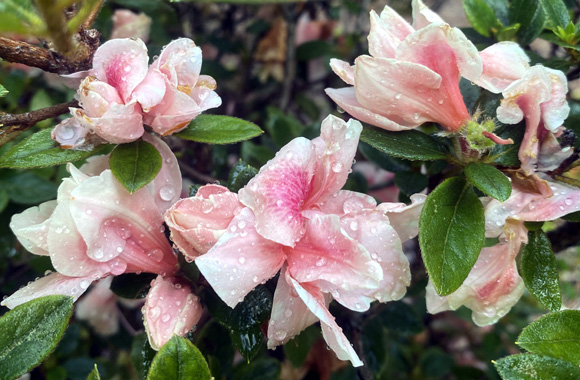
Three years ago I planted eight George Lindsey Tabor azaleas
and three Hilda Niblett azaleas in the treed area of the back
yard. Both varieties prefer shade and bloom just once for a few weeks in
the spring. They retain their leaves in the winter and grow a little
faster than Encore azaleas.
The Tabors can grow fairly tall but they are under enough shade that
they may not reach their full potential height where I planted them near
the back fence. Tabors are my favorite "old fashioned" azaleas
:
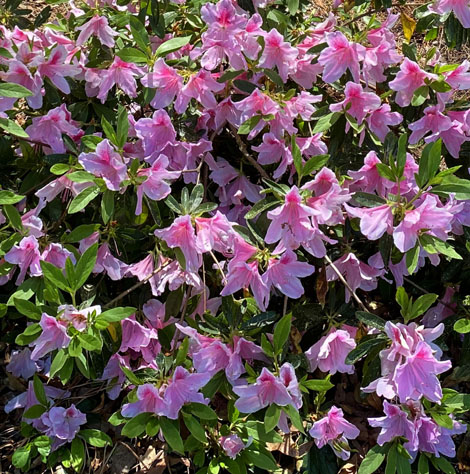
Hilda Nibletts are more like groundcover azaleas, keeping a low
profile. I love the range of colors of the flowers on the same plant
from pale pink to darker pink or coral:
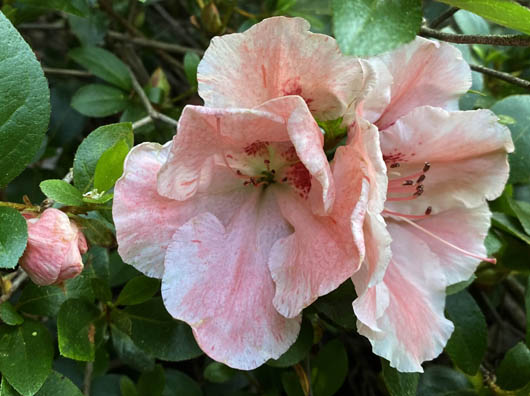
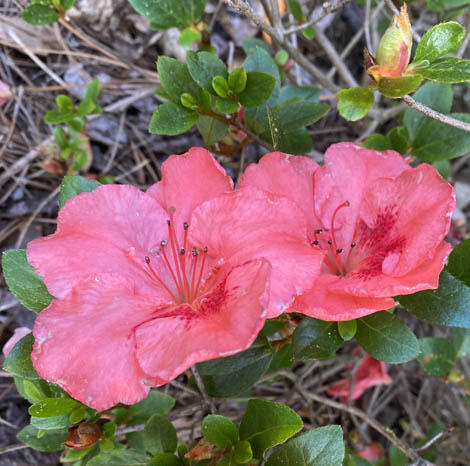
The floral show continues in the next entry . . .
Happy trails,
Sue
"Runtrails & Company" - Sue Norwood, Jim O'Neil,
Casey-Girl, Holly-Holly, & Dapper Don
Previous
Next
© 2021 Sue Norwood and Jim O'Neil
